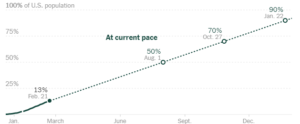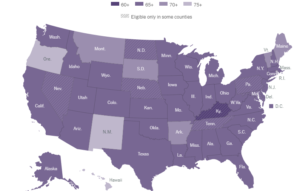
Suppliers are currently delivering an average of about 1.46 million doses per day. Additionally, President Biden has promised to administer 100 million doses by his 100th day in office. He set the goal shortly after taking office last month, aiming for the U.S. to administer more than 1.5 million doses per day, despite criticism that the number was not ambitious enough.
Federal regulators have granted emergency approval for vaccines developed by Pfizer-BioNTech and Moderna. Currently, both vaccines require patients to receive two doses several weeks apart.
Furthermore, the federal government has provided approximately 75.2 million doses to states, territories, and federal agencies.
Some experts estimate that 70 to 90% of the population needs to develop resistance to the coronavirus to achieve herd immunity, when virus transmission significantly slows because enough people are protected through infection or vaccination.
Several factors will determine how quickly this threshold is met, particularly the rate at which newly vaccinated individuals join those already immune from previous infections. However, the presence of more transmissible virus variants could complicate this progress.
The forecast below shows the percentage of the total population that has received at least one dose based on current vaccination rates, providing a preliminary view of how quickly virus transmission is expected to slow.
If the nation maintains its current pace of first-dose vaccinations, about half of the population will be vaccinated by early August and nearly all by late January 2022, assuming supply commitments are met and vaccines eventually become available for children.

Some jurisdictions have been more effective than others in managing vaccine doses from the federal government. Statistics include states, territories, federal agencies, and three nations with special agreements with the United States: Palau, Micronesia, and the Marshall Islands. Winter weather delayed vaccine shipments this week and forced some vaccination sites in the South and Midwest to close.
Several factors contribute to differences among states and territories, including vaccine demand, delays in data reporting, and other logistical challenges. President Biden recently announced plans to expand supply and provide states with advance notice of the number of doses available each week.
Healthcare workers and residents of long-term care facilities have been eligible for vaccination in every state for weeks.
The federal government recently recommended that states allow people aged 65 and older to get vaccinated. However, states are allowed to set and implement their own plans, and some areas have deviated from those plans, resulting in a patchwork of policies across the nation.
The New York Times periodically surveys all 50 states and found that every state has begun widespread vaccination of older adults, although the minimum eligibility age varies nationwide.
At least 43 states and Washington, D.C. have also expanded vaccination programs based on occupation to include some non-healthcare workers, such as police officers, grocery store employees, or others at risk of virus exposure in their jobs. At least 29 states and Washington, D.C. are allowing some teachers to be vaccinated.
The sudden expansion of vaccine eligibility has also caused problems as states try to increase capacity while people rush to book vaccination appointments.

Vaccine distribution and administration data come from the Centers for Disease